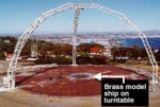
Naval Electronics Laboratory
Encyclopedia
The U.S. Navy Electronics Laboratory (NEL) was created in 1945, with the consolidation of the Navy Radio and Sound Lab and its wartime partner, the University of California Division of War Research
. NEL’s charter was “to effectuate the solution of any problem in the field of electronics
, in connection with the design, procurement, testing, installation and maintenance of electronic equipment for the U.S. Navy.” Its radio
communications and sonar
work was augmented with basic research in the propagation of electromagnetic energy in the atmosphere
and of sound
in the ocean
.
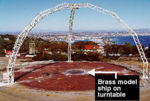 As one of its first projects, NEL began building its Shipboard Antenna Model Range. The non-metallic arch of this structure supports a transmitting antenna which is positioned toward a brass
As one of its first projects, NEL began building its Shipboard Antenna Model Range. The non-metallic arch of this structure supports a transmitting antenna which is positioned toward a brass
model ship on a turntable. The ground
plane under the arch simulates the electrical characteristics of the ocean. Allowing research on the properties of shipboard antennas to be carried out.
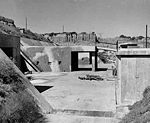 It also began conversion of a World War II
It also began conversion of a World War II
mortar emplacement, Battery Whistler, into an Arctic Submarine Laboratory
. Scientific exploration of the Arctic Basin
, and particularly providing the capability to operate attack submarines in the Arctic under the ice canopy
, would become a key NEL mission.
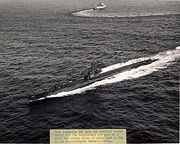 World headlines came early in this program from several events—the submerged voyage of USS Nautilus
World headlines came early in this program from several events—the submerged voyage of USS Nautilus
from the Pacific
to the Atlantic
, via the North Pole
, in 1958, and the surfacing at the pole of USS Skate
the following year, both with NEL’s Dr. Waldo Lyon aboard as chief scientist and ice pilot.
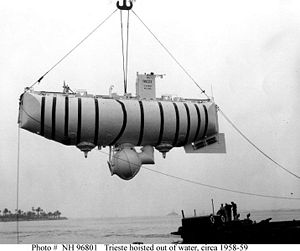 NEL also plunged into the undersea environment, acquiring the Bathyscaphe Trieste
NEL also plunged into the undersea environment, acquiring the Bathyscaphe Trieste
and directing its 1960 dive over 35,000 feet (10.7 km) down into the Challenger Deep
of the Mariana Trench
near Guam
.
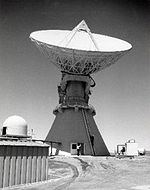 Interested in radio physics in general, the lab built a 60 feet (18.3 m)-diameter radio telescope
Interested in radio physics in general, the lab built a 60 feet (18.3 m)-diameter radio telescope
on Point Loma, and in 1964, NEL began construction of the La Posta Astro-Geophysical Observatory
on a 3900 feet (1,188.7 m) site in the Laguna Mountains
, 65 miles (104.6 km) east of San Diego. The observatory played a major role in solar radio mapping
, studies of environmental disturbances, and development of a solar optical videometer for microwave
research. Its 60 feet (18.3 m) dish, which could both transmit and receive, was used for important Center research programs in propagation and ionospheric
forecasting which was used during a number of Apollo
space launches to predict solar
activity that might hamper communications from the ground to the space capsules.
, a low-frequency
/very-low-frequency
(LF/VLF) system to provide information to deeply submerged Polaris missile submarines, and began development of satellite
communication capabilities.
Requirements for handling the vast amount of shipboard communications during the intensifying Vietnam War
led to tasking for an internal message handling system. In response, the lab developed the Message Processing and Distribution System (MPDS), installing it aboard the Seventh Fleet flagship USS Oklahoma City
a month ahead of schedule. The lab improved substantially on that system later and installed it aboard Nimitz-class
aircraft carriers.
was developed by and named after the lab.
NELIAC was the brainchild of Harry Huskey
, at the time Chairman of the ACM, who had a keen interest in porting applications in a machine-independent form. ALGOL 58 gave NEL the framework for an implmentation, and work commenced in 1958, but was not fully developed until 1961.
NELIAC was used at NEL to support experimental anti-submarine systems and Command and Control Systems development, and later, at the Navy Command Systems and Support Activity (NAVCOSSACT) in Washington DC in support of the National Emergency Command Post Afloat (NECPA) project which was installed on many large ships starting in 1966.
This was the world's first self-compiling compiler and was ported to many other computers in the Department of Defense, it also included the NELOS operating system development used for large scale applications (unique to the USQ-20 Navy shipboard computer and its commercial version, the UNIVAC 490).
Many other versions existed for a variety of computers because the ease of portability and the rapid one-pass compile times.
In 1997, with the disestablishment of NCCOSC and the establishment of direct oversight by Space and Naval Warfare Systems Command, the Center assumed its current name, Space and Naval Warfare Systems Center San Diego
(SSC San Diego).
University of California Division of War Research
The University of California Division of War Research was created at Scripps Institution of Oceanography at the University of California, San Diego campus during World War II to aid the U.S. Navy in war-related research....
. NEL’s charter was “to effectuate the solution of any problem in the field of electronics
Electronics
Electronics is the branch of science, engineering and technology that deals with electrical circuits involving active electrical components such as vacuum tubes, transistors, diodes and integrated circuits, and associated passive interconnection technologies...
, in connection with the design, procurement, testing, installation and maintenance of electronic equipment for the U.S. Navy.” Its radio
Radio
Radio is the transmission of signals through free space by modulation of electromagnetic waves with frequencies below those of visible light. Electromagnetic radiation travels by means of oscillating electromagnetic fields that pass through the air and the vacuum of space...
communications and sonar
Sonar
Sonar is a technique that uses sound propagation to navigate, communicate with or detect other vessels...
work was augmented with basic research in the propagation of electromagnetic energy in the atmosphere
Earth's atmosphere
The atmosphere of Earth is a layer of gases surrounding the planet Earth that is retained by Earth's gravity. The atmosphere protects life on Earth by absorbing ultraviolet solar radiation, warming the surface through heat retention , and reducing temperature extremes between day and night...
and of sound
Sound
Sound is a mechanical wave that is an oscillation of pressure transmitted through a solid, liquid, or gas, composed of frequencies within the range of hearing and of a level sufficiently strong to be heard, or the sensation stimulated in organs of hearing by such vibrations.-Propagation of...
in the ocean
Ocean
An ocean is a major body of saline water, and a principal component of the hydrosphere. Approximately 71% of the Earth's surface is covered by ocean, a continuous body of water that is customarily divided into several principal oceans and smaller seas.More than half of this area is over 3,000...
.
Shipboard Antenna Model Range

Brass
Brass is an alloy of copper and zinc; the proportions of zinc and copper can be varied to create a range of brasses with varying properties.In comparison, bronze is principally an alloy of copper and tin...
model ship on a turntable. The ground
Ground (electricity)
In electrical engineering, ground or earth may be the reference point in an electrical circuit from which other voltages are measured, or a common return path for electric current, or a direct physical connection to the Earth....
plane under the arch simulates the electrical characteristics of the ocean. Allowing research on the properties of shipboard antennas to be carried out.
Arctic submarine exploration

World War II
World War II, or the Second World War , was a global conflict lasting from 1939 to 1945, involving most of the world's nations—including all of the great powers—eventually forming two opposing military alliances: the Allies and the Axis...
mortar emplacement, Battery Whistler, into an Arctic Submarine Laboratory
Arctic Submarine Laboratory
The Arctic Submarine Laboratory was a research facility of the U.S. Navy's Electronics Laboratory in San Diego, California. It began as a converted World War II mortar emplacement, Battery Whistler, and was focused on scientific exploration of the Arctic Basin, and particularly providing the...
. Scientific exploration of the Arctic Basin
Arctic Ocean
The Arctic Ocean, located in the Northern Hemisphere and mostly in the Arctic north polar region, is the smallest and shallowest of the world's five major oceanic divisions...
, and particularly providing the capability to operate attack submarines in the Arctic under the ice canopy
Sea ice
Sea ice is largely formed from seawater that freezes. Because the oceans consist of saltwater, this occurs below the freezing point of pure water, at about -1.8 °C ....
, would become a key NEL mission.

USS Nautilus (SSN-571)
USS Nautilus is the world's first operational nuclear-powered submarine. She was the first vessel to complete a submerged transit beneath the North Pole on August 3, 1958...
from the Pacific
Pacific Ocean
The Pacific Ocean is the largest of the Earth's oceanic divisions. It extends from the Arctic in the north to the Southern Ocean in the south, bounded by Asia and Australia in the west, and the Americas in the east.At 165.2 million square kilometres in area, this largest division of the World...
to the Atlantic
Atlantic Ocean
The Atlantic Ocean is the second-largest of the world's oceanic divisions. With a total area of about , it covers approximately 20% of the Earth's surface and about 26% of its water surface area...
, via the North Pole
North Pole
The North Pole, also known as the Geographic North Pole or Terrestrial North Pole, is, subject to the caveats explained below, defined as the point in the northern hemisphere where the Earth's axis of rotation meets its surface...
, in 1958, and the surfacing at the pole of USS Skate
USS Skate (SSN-578)
USS Skate , the third submarine of the United States Navy named for the skate, a type of ray, was the lead ship of the Skate class of nuclear submarines...
the following year, both with NEL’s Dr. Waldo Lyon aboard as chief scientist and ice pilot.
Bathyscaphe Trieste

Bathyscaphe Trieste
The Trieste is a Swiss-designed, Italian-built deep-diving research bathyscaphe with a crew of two, which reached a record maximum depth of about , in the deepest known part of the Earth's oceans, the Challenger Deep, in the Mariana Trench near Guam, on January 23, 1960, crewed by Jacques Piccard ...
and directing its 1960 dive over 35,000 feet (10.7 km) down into the Challenger Deep
Challenger Deep
The Challenger Deep is the deepest known point in the oceans, with a depth of to by direct measurement from submersibles, and slightly more by sonar bathymetry . It is located at the southern end of the Mariana Trench near the Mariana Islands group...
of the Mariana Trench
Mariana Trench
The Mariana Trench or Marianas Trench is the deepest part of the world's oceans. It is located in the western Pacific Ocean, to the east of the Mariana Islands. The trench is about long but has a mean width of only...
near Guam
Guam
Guam is an organized, unincorporated territory of the United States located in the western Pacific Ocean. It is one of five U.S. territories with an established civilian government. Guam is listed as one of 16 Non-Self-Governing Territories by the Special Committee on Decolonization of the United...
.
Radio telescopes

Radio telescope
A radio telescope is a form of directional radio antenna used in radio astronomy. The same types of antennas are also used in tracking and collecting data from satellites and space probes...
on Point Loma, and in 1964, NEL began construction of the La Posta Astro-Geophysical Observatory
La Posta Astro-Geophysical Observatory
The La Posta Astro-Geophysical Observatory was a Naval Electronics Laboratory radio-telescope at Campo, CA.Construction began in 1964 at a site in the Laguna Mountains, 65 miles east of San Diego.- History :...
on a 3900 feet (1,188.7 m) site in the Laguna Mountains
Laguna Mountains
The Laguna Mountains are a section of the Peninsular Ranges in eastern San Diego County, California. The mountains run in a northwest/southeast alignment for approximately ....
, 65 miles (104.6 km) east of San Diego. The observatory played a major role in solar radio mapping
Radio astronomy
Radio astronomy is a subfield of astronomy that studies celestial objects at radio frequencies. The initial detection of radio waves from an astronomical object was made in the 1930s, when Karl Jansky observed radiation coming from the Milky Way. Subsequent observations have identified a number of...
, studies of environmental disturbances, and development of a solar optical videometer for microwave
Microwave
Microwaves, a subset of radio waves, have wavelengths ranging from as long as one meter to as short as one millimeter, or equivalently, with frequencies between 300 MHz and 300 GHz. This broad definition includes both UHF and EHF , and various sources use different boundaries...
research. Its 60 feet (18.3 m) dish, which could both transmit and receive, was used for important Center research programs in propagation and ionospheric
Ionosphere
The ionosphere is a part of the upper atmosphere, comprising portions of the mesosphere, thermosphere and exosphere, distinguished because it is ionized by solar radiation. It plays an important part in atmospheric electricity and forms the inner edge of the magnetosphere...
forecasting which was used during a number of Apollo
Project Apollo
The Apollo program was the spaceflight effort carried out by the United States' National Aeronautics and Space Administration , that landed the first humans on Earth's Moon. Conceived during the Presidency of Dwight D. Eisenhower, Apollo began in earnest after President John F...
space launches to predict solar
Sun
The Sun is the star at the center of the Solar System. It is almost perfectly spherical and consists of hot plasma interwoven with magnetic fields...
activity that might hamper communications from the ground to the space capsules.
Communications
In the area of communications, NEL developed VerdinTACAMO
TACAMO is a U.S. military term meaning "Take Charge and Move Out". TACAMO refers to a system of survivable communications links designed to be used in nuclear war to maintain communications between the decision makers and the triad of strategic nuclear weapon delivery systems...
, a low-frequency
Low frequency
Low frequency or low freq or LF refers to radio frequencies in the range of 30 kHz–300 kHz. In Europe, and parts of Northern Africa and of Asia, part of the LF spectrum is used for AM broadcasting as the longwave band. In the western hemisphere, its main use is for aircraft beacon,...
/very-low-frequency
Very low frequency
225px|thumb|right|A VLF receiving antenna at [[Palmer Station]], Antarctica, operated by Stanford UniversityVery low frequency or VLF refers to radio frequencies in the range of 3 kHz to 30 kHz. Since there is not much bandwidth in this band of the radio spectrum, only the very simplest signals...
(LF/VLF) system to provide information to deeply submerged Polaris missile submarines, and began development of satellite
Satellite
In the context of spaceflight, a satellite is an object which has been placed into orbit by human endeavour. Such objects are sometimes called artificial satellites to distinguish them from natural satellites such as the Moon....
communication capabilities.
Requirements for handling the vast amount of shipboard communications during the intensifying Vietnam War
Vietnam War
The Vietnam War was a Cold War-era military conflict that occurred in Vietnam, Laos, and Cambodia from 1 November 1955 to the fall of Saigon on 30 April 1975. This war followed the First Indochina War and was fought between North Vietnam, supported by its communist allies, and the government of...
led to tasking for an internal message handling system. In response, the lab developed the Message Processing and Distribution System (MPDS), installing it aboard the Seventh Fleet flagship USS Oklahoma City
USS Oklahoma City (CLG-5)
USS Oklahoma City was one of 27 United States Navy light cruisers completed during or shortly after World War II, and one of six to be converted to guided missile cruisers. She was the first US Navy ship to be named for Oklahoma City, Oklahoma...
a month ahead of schedule. The lab improved substantially on that system later and installed it aboard Nimitz-class
Nimitz class aircraft carrier
The Nimitz-class supercarriers are a class of ten nuclear-powered aircraft carriers in service with the United States Navy. With an overall length of and full-load displacements of over 100,000 long tons, they are the largest capital ships in the world...
aircraft carriers.
Computer science
The programming language dialect NELIACNELIAC
The Navy Electronics Laboratory International ALGOL Compiler or NELIAC is a dialect and compiler implementation of the ALGOL 58 programming language developed by the Naval Electronics Laboratory in 1958....
was developed by and named after the lab.
NELIAC was the brainchild of Harry Huskey
Harry Huskey
Harry Douglas Huskey is an American computer designer pioneer.Huskey was born in the Smoky Mountains region of North Carolina and grew up in Idaho. He gained his Master's and then his PhD in 1943 from the Ohio State University on Contributions to the Problem of Geocze...
, at the time Chairman of the ACM, who had a keen interest in porting applications in a machine-independent form. ALGOL 58 gave NEL the framework for an implmentation, and work commenced in 1958, but was not fully developed until 1961.
NELIAC was used at NEL to support experimental anti-submarine systems and Command and Control Systems development, and later, at the Navy Command Systems and Support Activity (NAVCOSSACT) in Washington DC in support of the National Emergency Command Post Afloat (NECPA) project which was installed on many large ships starting in 1966.
This was the world's first self-compiling compiler and was ported to many other computers in the Department of Defense, it also included the NELOS operating system development used for large scale applications (unique to the USQ-20 Navy shipboard computer and its commercial version, the UNIVAC 490).
Many other versions existed for a variety of computers because the ease of portability and the rapid one-pass compile times.
Naval Command, Control and Communications Laboratory Center and beyond
In 1967, as part of the general Navy laboratory re-organization, NEL became the Naval Command, Control and Communications Laboratory Center. The name was never fully accepted, and in about six months it was changed to Naval Electronics Laboratory Center (NELC).In 1997, with the disestablishment of NCCOSC and the establishment of direct oversight by Space and Naval Warfare Systems Command, the Center assumed its current name, Space and Naval Warfare Systems Center San Diego
Space and Naval Warfare Systems Center San Diego
Space and Naval Warfare Systems Center Pacific is the U.S. Navy's research, development, test and evaluation, engineering and fleet support center for command, control and communication systems and ocean surveillance. SSC Pacific provides information resources to support the joint warfighter in...
(SSC San Diego).

